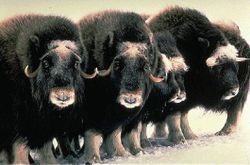Muskox: Difference between revisions
CRKingston (talk | contribs) added category |
Removed category not appropriate |
||
| Line 58: | Line 58: | ||
[[Category:Arctic land animals]] |
[[Category:Arctic land animals]] |
||
[[Category:Caprids]] |
[[Category:Caprids]] |
||
[[Category:Kara Sea]] |
|||
{{Link FA|de}} |
{{Link FA|de}} |
||
Revision as of 23:47, 3 February 2007
| Muskox | |
|---|---|

| |
| Scientific classification | |
| Kingdom: | |
| Phylum: | |
| Class: | |
| Order: | |
| Family: | |
| Subfamily: | |
| Genus: | Ovibos Blainville, 1816
|
| Species: | O. moschatus
|
| Binomial name | |
| Ovibos moschatus (Zimmermann, 1780)
| |
The muskox (Ovibos moschatus) is an arctic mammal of the Bovidae family, noted for its thick coat and for the male's strong odor, hence the name.
Physical characteristics
It belongs to the Caprinae subfamily, being more closely related to goats than to oxen, but is in its own genus, Ovibos. Both sexes have long curved horns. Muskoxen are usually around 2.5 m (8.2 ft) long and 1.4 m (4.6) high at the shoulder. Adults usually weigh at least 200 kg (440 lb) and can exceed 400 kg (880 lb). Their coat, a mix of black, gray, and brown, includes long guard hairs that reach almost to the ground.
During the summer, muskoxen live in wet areas, such as river valleys, moving to higher elevations in the winter to avoid deep snow. They graze on grasses, reeds, sedges, and other ground plants, digging through snow in the winter to reach their food.
Muskoxen are social and live in herds, usually of around 10–20 animals, but sometimes over 400. Winter herds consist of adults of both sexes as well as young animals. During the mating season, which peaks in mid-August, males compete for dominance, and one dominant bull drives other adult males out of the group. Non-breeding males will often form male only herds of 3-10 or wander the tundra alone. During this period all males are extremely aggressive. Bulls will even charge birds if they are close by.

Females are sexually mature at two years of age, and males reach sexual maturity after five years. The gestation period is eight or nine months. Almost all pregnancies yield single calves. The young nurse for a year, but may start to eat grasses as soon as a week after birth.
Muskoxen have a distinctive defensive behavior: when the herd is threatened, the bulls and cows will face outward to form a stationary ring around the calves. This is an effective defense against predators such as wolves, but makes them an easy target for human hunters.
Muskox wool, or qiviut (an Inuit word), is highly prized for its softness, length, and insulative value.
The muskox, or its ancestor, is believed have migrated to North America between 200,000 years[1] and 90,000 years ago.[2] It is agreed however that the muskox was alive in the Pleistocene period[3] making it a contemporary of the Mammoth. It is thought that the muskox was able to survive the last ice age (Wisconsin glaciation) by finding ice free areas away from prehistoric peoples[2]. The muskox gradually moved across North America and arrived in Greenland during the late Holocene[4].
Habitat and range
Muskoxen are native to the Arctic areas of Canada, Greenland, and Alaska. The Alaska population was wiped out in the late nineteenth or early twentieth century, but muskoxen have since been reintroduced to Alaska. The species has also been reintroduced from Banks Island to northern Europe, including Sweden, the Dovre region of Norway, and Russia and from Ellesmere island to Eastern Canada, in the province of Quebec. Muskoxen were close to extinction at one point, but have recovered after being protected from hunting. The world population (as of 1999) is estimated at between 65,000 and 85,000, with two thirds living on Banks Island. It is increasing, especially in the areas where the animal was introduced in the 20th century.

Trivia
- The last known muskox from outside North America, that lived on the Taymyr Peninsula of Siberia, died out about 2,000 years ago[3].
- Rare "white muskox" have been spotted in the Queen Maud Gulf Migratory Bird Sanctuary[5]
- U.S President Richard Nixon sent the Chinese government a pair of muskoxen as a gift in 1972, after China sent the pandas Ling-Ling and Hsing-Hsing to America.
- The Norwegian municipality of Dovre has a muskox in its coat-of-arms.
References
External links
- Ellis, E. Ovibos moschatus.
- Robert G. White Large Animal Research Station at the University of Alaska Fairbanks
- Alaska Zoo
- Jork Meyer, "Sex ratio in muskox skulls (Ovibos moschatus) found at East Greenland" (Geschlechterverhältnis bei Schädeln des Moschusochsen (Ovibos moschatus) in Ostgrönland) Beiträge zur Jagd- und Wildtierforschung 29 (2004): 187-192.

